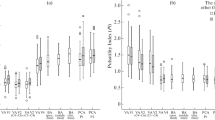Summary
During the past 33 months we have investigated 6,587 patients using directional continuous-wave Doppler sonography of the carotid arteries. On the basis of 1,671 retrograde brachial and direct carotid angiograms we have developed criteria for demonstrating a significant increase in the peripheral resistance of the internal carotid artery. We distinguished stenoses proximal (15 cases) and distal (4) to the origin of the ophthalmic artery, supraclinoid internal carotid artery occlusions (8), stenoses (2) and obliterations (10) of the middle cerebral artery that developed suddenly. Stenoses in the carotid siphon (proximal or distal to the origin of the ophthalmic artery) showed a reduction of more than 40% in the relative end-diastolic flow velocity (modified Pourcelot's index); in addition, stenoses proximal to the origin of the ophthalmic artery exhibited an alternating flow, or flow reversal, in the supratrochlear artery to a variable extent. Stenoses distal to the origin of the ophthalmic artery only rarely revealed the increase in orthograde flow velocity that had been theoretically expected in the supratrochlear artery. Stenoses of the middle cerebral artery exceeding the extent of atherosclerotic irregularities proved to be an exception. Supraclinoid obliterations of the internal carotid artery were reliably demonstrated by Doppler sonography. However, the majority of the occlusions of the middle cerebral artery that developed suddenly could not be detected by this means, probably due to anastomoses between the anterior and middle cerebral arteries, which were detected by means of angiography. Thus, we believe that continuous-wave Doppler sonography is a reliable tool for detecting stenoses of the carotid siphon of more than 60% reduction in lumen diameter as well as supraclinoid carotid artery occlusions. Resistance to the cerebral blood flow that is located more peripherally cannot be diagnosed reliably by this method.
Zusammenfassung
Wir haben 6587 Patienten innerhalb der letzten 33 Monate mit der direktionellen Doppler-Sonographie der Carotiden untersucht und auf der Grundlage von 1671 retrograden Brachialis- bzw. perkutanen Carotisarteriographien sonographische Kriterien für den Nachweis einer wesentlichen Widerstandserhöhung im peripheren Gefäßbett der A. carotis interna entwickelt. Nach der Lokalisation unterscheiden wir Stenosen vor dem Abgang der A. ophthal mica (15 Fälle) bzw. nach Abgang der A. ophthalmica (4), supraclinoidale Internaverschlüsse (8), Mediastenosen (2) und Mediaverschlüsse (10). Siphonstenosen (vor oder nach Abgang der A. ophthalmica) von mehr als 60% (angiographisch) zeigten stets eine über 40%ige Reduktion der relativen enddiastolischen Strömungsgeschwindigkeit (modifizierter Index nach Pourcelot), die Stenosen vor Abgang der A. ophthalmica zusätzlich Veränderungen an der A. supratrochlearis in variablem Ausmaß in Form eines Nullflusses, eines alternierenden Flusses oder einer Strömungsumkehr. Bei Stenosen und Verschlüssen distal des Ophthalmicaabganges fand sich nur selten der theoretisch erwartete erhöhte orthograde Fluß in der A. supratrochlearis. Mediastenosen, die über das Ausmaß arteriosklerotischer Wandunregelmä-ßigkeiten hinausgingen, waren in dem von uns untersuchten Krankengut eine Seltenheit. Die supraclinoidalen Internaverschlüss wurden Doppler-sonographisch zuverlässig erkannt, während akut aufgetretene Mediaverschlüsse in der überwiegendee Zahl der Fälle nicht mittels Doppler-sonographischer Kriterien erfaßt werden konnten, wahrscheinlich aufgrund der angiographisch nachweisbaren Kollateralenbildung zwischen den Aa. cerebri ant. und media. Wir sind zu dem Ergebnis gekommen, daß die Doppler-Sonographie als sensitive Methode zur nichtinvasiven Diagnose von Siphonstenosen über 60% sowie der supraclinoidalen Internaobliterationen eingesetzt werden kann, während weiter peripher gelegene Strömungshindernisse in der Mehrzahl der Fälle mittels dieser Methode nicht nachgewiesen werden können.
Similar content being viewed by others
Literatur
Aaslid R, Markwalder TM, Nornes H (1982) Noninvasive transcranial Doppler ultrasound recording of flow velocity in basal cerebral arteries. J Neurosurg 57:769–774
Reutern GM von, Freund HJ (1982) Doppler-Sonographie der extrakraniellen Hirnarterien. Georg Thieme Verlag, Stuttgart
Müller HR (1971) Direktionelle Doppler-Sonographie der Arteria frontalis medialis. EEG-EMG 2:24–32
Müller HR (1976) Doppler-Sonographie der Carotis-Strombahn. Internist 17:570–579
Pourcelot L (1976) Diagnostic ultrasound for cerebral vascular diseases. In: Donald I, Levi S (eds) Present and future of diagnostic ultrasound. John Wiley, New York, pp 141–147
Reutern GM von, Büdingen HJ, Hennerici M, Freund HJ (1976) Diagnose und Differenzierung von Stenosen und Verschlüssen der Arteria carotis mit der Doppler-Sonographie. Arch Psychiatr Nervenkr 222:191–207
Reutern GM von, Voigt K, Ortega-Suhrkamp E, Büdingen HJ (1977) Dopplersonographische Befunde bei intrakraniellen vaskulären Störungen. Arch Psychiatr Nervenkr 223:181–196
Author information
Authors and Affiliations
Rights and permissions
About this article
Cite this article
Biedert, S., Winter, R., Betz, H. et al. Die Doppler-sonographie bei intracraniellen zirkulationsstörungen der A. carotis interna Eine Doppler-sonographisch-angiographische vergleichsuntersuchung. Eur Arch Psychiatr Neurol Sci 234, 378–389 (1985). https://doi.org/10.1007/BF00386055
Received:
Issue Date:
DOI: https://doi.org/10.1007/BF00386055




